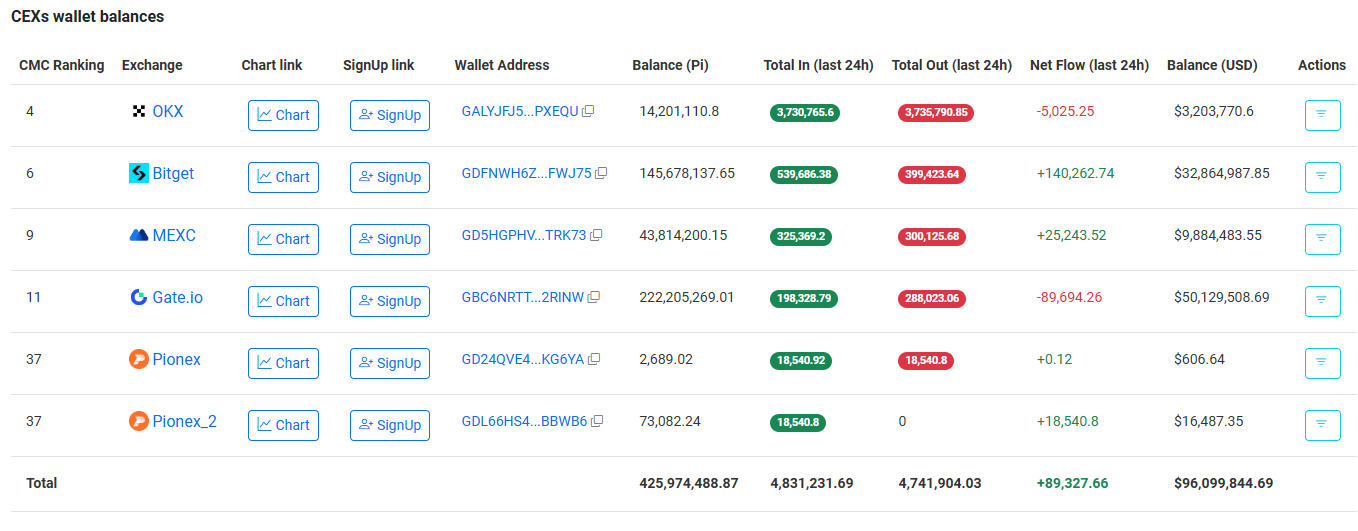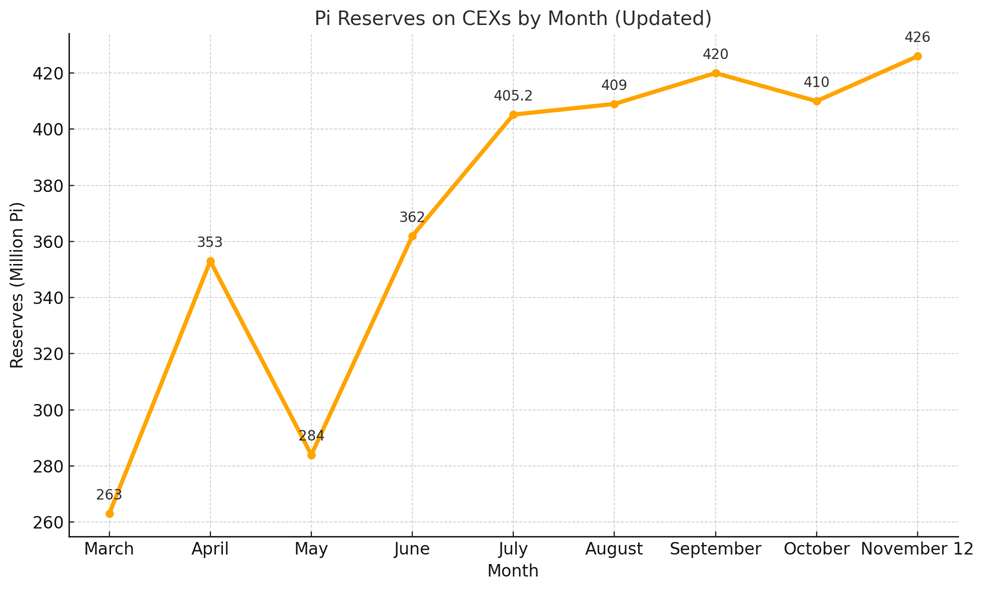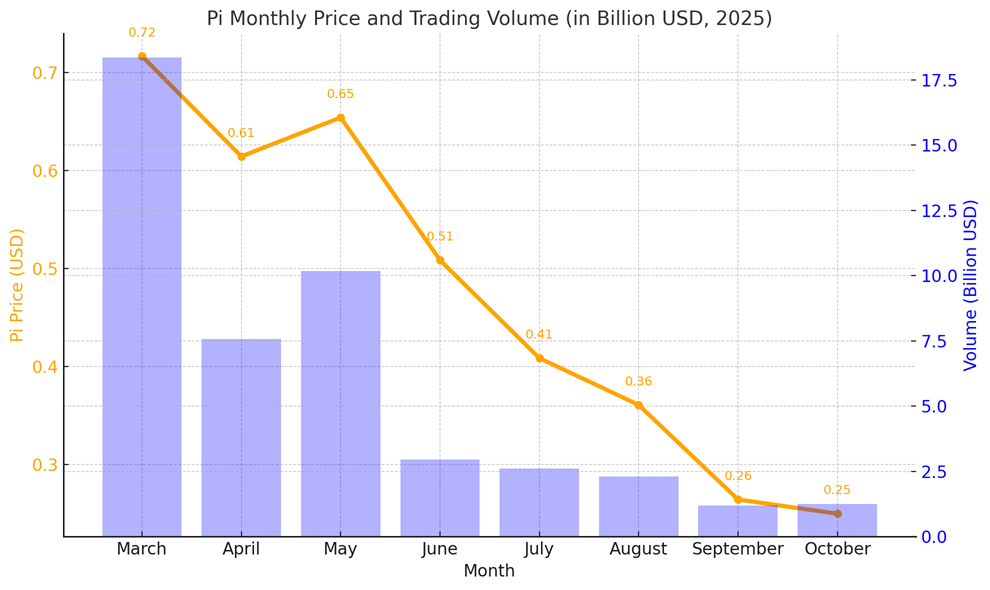3 Signs Pointing to Mounting Selling Pressure on Pi Network in November
Pi Network’s price may hit new lows in November as massive token unlocks, rising exchange reserves, and weak liquidity weigh on sentiment. Yet, loyal supporters remain hopeful that long-term fundamentals will eventually spark a rebound.
Trading data for Pi Network (PI) signals a bearish outlook for its price in November. Although Pi has already dropped more than 90% from its peak, market forces may continue to push the price lower.
What are the warning signs, and how do Pi’s loyal supporters explain them?
A Massive Amount of Pi Tokens Being Unlocked
First, Piscan data shows that the number of Pi unlocked per day is up to 4.85 million PI, and the number of Pi unlocked in the next 30 days is up to 145 million Pi.
 Number of Pi Tokens Unlocked Per Day. Source:
Piscan
Number of Pi Tokens Unlocked Per Day. Source:
Piscan
Piscan data also reveals that in December, more than 173 million Pi will be unlocked — the highest monthly unlock volume until September 2027.
This steady and increasing unlock pressure is likely to persist through the end of the year, creating a significant obstacle to any price recovery on exchanges.
Rising Exchange Balances Indicate Continuous Selling Pressure
The amount of Pi held on exchanges continues to increase in November.
 Pi Supply on Exchanges. Source:
Piscan
Pi Supply on Exchanges. Source:
Piscan
According to Pi Network’s early-month report, there were about 423 million Pi on exchanges. By mid-November, that figure had climbed to nearly 426 million Pi, marking an all-time high.
 Pi Reserves on CEXs by Month. Source: Data Curated by BeInCrypto
Pi Reserves on CEXs by Month. Source: Data Curated by BeInCrypto
Such growth in exchange reserves indicates that exchanges now hold more Pi tokens, ready for trading or sale, which could put downward pressure on prices.
Weak Trading Volume Reflects Low Market Activity
Spot trading volume for Pi on centralized exchanges has shown little improvement in November. The 24-hour trading volume currently hovers around $30 million.
CoinMarketCap data indicates that Pi’s monthly trading volume fell to just $1.2 billion last month. Both price and trading volume have declined in parallel.
 Pi Monthly Price & Trading Volume. Source:
CoinmarketCap
Pi Monthly Price & Trading Volume. Source:
CoinmarketCap
Weak liquidity, along with the constant unlocking and inflow of Pi to exchanges, could intensify the downward price movement.
Pi Supporters Remain Confident Despite the Pressure
Despite the bearish signals, Pi supporters remain optimistic.
An X account named Dao World, identifying as a Pioneer, argued that while Pi has a large maximum supply, the actual circulating amount is only around 3 billion. The Pi Core Team, he noted, has not been aggressively selling.
He also suggested that a few market makers (MM) on certain exchanges mainly control Pi’s current price. Once selling pressure is fully absorbed, he believes the price could rebound.
Even though $Pi has a large max supply, considering that the CT has not been aggressively selling tokens and the actual circulating supply is only a little over 3B, and price action is largely managed by MM on a few exchanges — am I the only one who thinks that when it’s time for… pic.twitter.com/0GUIXfx2EF
— Dao world November 11, 2025
Several other Pioneers share this view, claiming that the current $0.20 range presents a buying opportunity — one they expect will be remembered fondly in the future.
Disclaimer: The content of this article solely reflects the author's opinion and does not represent the platform in any capacity. This article is not intended to serve as a reference for making investment decisions.
You may also like
Accelerated Pathways Help Close the Gap Between ACS Guidelines and Actual Clinical Practice
- A Hunan hospital study found fast-track pathways for ACS patients reduced treatment delays and MACE without increased bleeding risk. - The protocol cut median door-to-ECG time by 50% and door-to-balloon time for STEMI patients to 68 minutes, improving guideline adherence. - In-hospital MACE rates dropped from 11.6% to 6.6%, with 30-day composite outcomes improving from 13.9% to 8.7% under fast-track care. - Researchers emphasized the pathway's applicability across all ACS subtypes and potential system ef

Crypto Supporters Rally Ahead of 2026 Midterm Elections to Influence a Congress Favoring Innovation
- Stand With Crypto, backed by Coinbase , launched a 2026 midterm campaign to evaluate candidates' digital asset policies, focusing on innovation, de-banking, and regulation. - The group aims to influence Congress to prioritize pro-crypto policies, leveraging prior success in mobilizing voters and tracking 274 "pro-crypto" elected officials in 2024. - SEC's 2026 regulatory shift to information security and delayed digital asset legislation create uncertainty, while Trump's political strategies intersect wi

Ethereum News Update: While Ethereum Declines, DeFi's Mutuum Rises Amid Presale Boom
- Ethereum (ETH) fell below $2,800 on Nov 24, 2025, amid crypto market turmoil driven by rising Japanese bond yields and algorithmic sell-offs. - DeFi project Mutuum Finance (MUTM) raised $18.9M in its presale, with Phase 6 nearing 90% sales at $0.035 per token before a 20% price increase. - Mutuum's dual-lending model and automated interest systems differentiate it, while Ethereum ETFs saw $465M outflows despite institutional Bitcoin/Ethereum deposits. - The project's presale growth remains resilient amid

XRP News Update: Franklin XRP ETF: $1.69 Trillion Titan Signals Crypto Market Evolution
- Franklin Templeton launches XRPZ ETF, first regulated XRP fund on NYSE Arca, reflecting institutional crypto adoption. - SEC's 2025 Ripple settlement cleared XRP's regulatory status, enabling $125M-payout-driven investment products like XRPZ. - XRPZ joins competitive ETF landscape (Bitwise, Grayscale) amid mixed market signals: $2.11 price rebound vs. 200M XRP whale sales. - Franklin's $1.69T AUM entry underscores crypto market maturation, with XRP positioned as foundational asset for cross-border paymen

